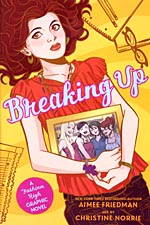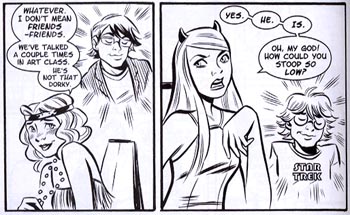 Written by Aimee Friedman
Written by Aimee Friedman
Art by Christine Norrie
192 pages, black and white
Published by Graphix/Scholastic Books
“Wouldn’t it be fun to go back and do it all again?” It’s a phrase that’s often aimed at the teenage/high school experience, and to be honest it’s a little mind-boggling. To me, high school life was punctuated with four years of confusing hormones, cruel teenagers (myself included), and generally immature behavior. Friendships were made and broken at the drop of a hat, no one had the answers they were looking for, and the rest of life was still one big question mark. Reading Aimee Friedman and Christine Norrie’s Breaking Up drove home two points along those lines for me. First, that high school really was exactly as I remembered it. Second, while I may be over twice as old as the characters in Breaking Up, some things in life really never do change.
 Chloe, Erika, Isabel, and MacKenzie are eleventh graders at the Georgia O’Keeffe School for the Arts, where trendy and talented go hand-in-hand, or at least walk by each other in the hallways. These four girls are the best of friends, sharing everything—classes, gossip, secrets, and opinions. What Chloe and the others are about to discover is that while wisdom does not necessarily come with age, change certainly does. The girls are slowly drifting apart, but can they mend their fences and reunite? And perhaps more importantly, is that something they really should even attempt?
Chloe, Erika, Isabel, and MacKenzie are eleventh graders at the Georgia O’Keeffe School for the Arts, where trendy and talented go hand-in-hand, or at least walk by each other in the hallways. These four girls are the best of friends, sharing everything—classes, gossip, secrets, and opinions. What Chloe and the others are about to discover is that while wisdom does not necessarily come with age, change certainly does. The girls are slowly drifting apart, but can they mend their fences and reunite? And perhaps more importantly, is that something they really should even attempt?
Friedman wastes no time in plunging the reader into the world of Fashion High, providing education on not only our main character and her group of immediate friends, but on the cliques and social standings of those around her. Like fellow Graphix-imprint graphic novel Queen Bee, social standings are crucial to Breaking Up. It drives a lot of the characters and defines their decisions in life, and while you may not always agree with what they’re saying or doing Friedman always makes it understandable. It’s an important part of Breaking Up, because it keeps people like MacKenzie from transforming into a one-dimensional villain. Instead she’s merely another confused high school student trying to make what she thinks are the best choices for herself, fumbling her way through life. That’s really most of the characters in the book, of course. Chloe makes both good and bad decisions throughout Breaking Up, but it’s to Friedman’s credit that as a reader we always care about Chloe and the outcome of those choices. Chloe’s an extremely likable person despite her occasional faults, and you really want her to succeed. One of the best things about Breaking Up, though, is that Friedman resists the urge to tie everything up in a neat bow at the conclusion of the book. The disintegration of a friendship—especially a close one—isn’t easy to fix, and there’s no magical solution offered here. In the end, a lot is left up in the air, just like real life. There’s certainly hope in the air, but it’s a tentative and fragile one. Part of Breaking Up‘s strength is its believability, and this part of the book is no exception.
 Norrie’s art for Breaking Up is unsurprisingly beautiful. She’s got a nice, gentle ink line that carefully forms the jaw lines and cascades of hair of her characters, bringing them to life in a realistic but unposed manner. Norrie pays close attention to fashions here, dressing the girls in a wide variety of outfits that both reflect their personalities and their ages in general. It gives the book an extra air of credibility, making Breaking Up feel like you’re getting a glimpse into a real group of people’s lives. Norrie’s able to make the book’s artistic flights of fancy seem believable, like Chloe’s sudden transformation into Hester Prynne from The Scarlet Letter in response to the idea of becoming a social leper for kissing the wrong boy, or hopscotching across puddles marked “tension,” “conflict,” and “argument” when thinking about hating her friends being upset with her. Best of all, though, is Norrie’s drawings of Adam Stevenson. Geeky and at the bottom of the school pecking order, Norrie at first draws him as our characters view him based on his social standing; awkward, nerdy, and avoidable. As Chloe gets to know him, though, Norrie slowly transforms how she draws him to reveal what he really is like. You really understand what Chloe’s beginning to see in him, even as we continue to see through other characters’s eyes the “old” Adam. It’s a nice contrast, really brought home when we see the two depictions of him side-by-side, and something that could really only be accomplished through Norrie’s art instead of just prose.
Norrie’s art for Breaking Up is unsurprisingly beautiful. She’s got a nice, gentle ink line that carefully forms the jaw lines and cascades of hair of her characters, bringing them to life in a realistic but unposed manner. Norrie pays close attention to fashions here, dressing the girls in a wide variety of outfits that both reflect their personalities and their ages in general. It gives the book an extra air of credibility, making Breaking Up feel like you’re getting a glimpse into a real group of people’s lives. Norrie’s able to make the book’s artistic flights of fancy seem believable, like Chloe’s sudden transformation into Hester Prynne from The Scarlet Letter in response to the idea of becoming a social leper for kissing the wrong boy, or hopscotching across puddles marked “tension,” “conflict,” and “argument” when thinking about hating her friends being upset with her. Best of all, though, is Norrie’s drawings of Adam Stevenson. Geeky and at the bottom of the school pecking order, Norrie at first draws him as our characters view him based on his social standing; awkward, nerdy, and avoidable. As Chloe gets to know him, though, Norrie slowly transforms how she draws him to reveal what he really is like. You really understand what Chloe’s beginning to see in him, even as we continue to see through other characters’s eyes the “old” Adam. It’s a nice contrast, really brought home when we see the two depictions of him side-by-side, and something that could really only be accomplished through Norrie’s art instead of just prose.
Breaking Up may be a book aimed at young adults, but I think there’s a lot here for everyone to enjoy. Conflicts between friends may not happen in an academic setting as life continues, but otherwise a lot of the story can be mapped onto the lives of older readers. Friedman and Norrie’s story of real life disasters rings true enough that it’s hard to imagine a reader not getting pulled into its orbit. The cover of Breaking Up proclaims it to be “A Fashion High Graphic Novel” and I’m hoping that means we’ll be seeing more of Chloe and company before too long. This creation is rich enough that you’ll want to go back for more.
Purchase Links:
